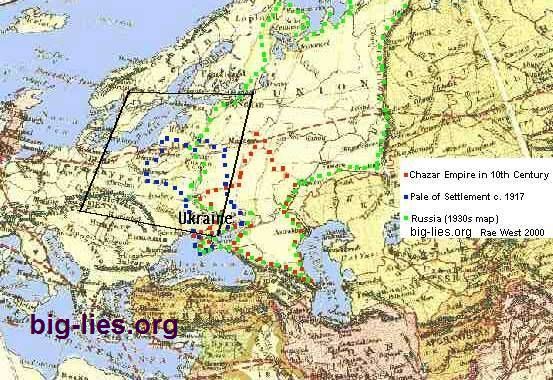Sorry to bore people with this. Just more dubious stuff. ...
The following comment was made on the BNPideas website by 'Ed' (who I think may be Arthur Kemp - he might be described as a white 'race historian' and though very sound will have nothing to do with 'conspiracy theories', apart from climate change, and the forcing of immigration into white countries; he has no science background). This is what 'Ed' said re the Khazar idea, very possibly copying it from somewhere else in his own writings:-
The “Khazar” theory has been thoroughly disproved by modern genetics. It is a myth.
The Khazars were a central Asian tribe. DNA studies of modern Jewish populations have shown that 12% of Ashkenazim Jews do have a central Asian DNA strand.
There is however no evidence that this 12% strain — which exists among a small group of male Ashkenazim Jews — is actually Khazarian in origin.
This DNA strand could be of any origin — but even if it is Khazar (and it is worth repeating that there is no proof for this) then it still comprises only 12% of Ashkenazim Jews, and therefore less than 6% of all Jews (Ashkenazim and Sephardic). Be careful not to propagate easily disproved lies as it will affect the credibility of all your arguments.
Source: “The Y Chromosome Pool of Jews as Part of the Genetic Landscape of the Middle East,” Almut Nebel,1 Dvora Filon,2 Bernd Brinkmann,4 Partha P. Majumder,5 Marina Faerman,3 and Ariella Oppenheim1, by The American Society of Human Genetics, Am J Hum Genet. 2001 November; 69(5): 1095–1112.
https://www.ncbi.nlm.nih.gov/pmc/articles/PMC1274378/
This was a 2001 piece of work. It's perhaps too long to include here; maybe some other time.
I replied to the BNP site--
Yes, thanks, ed. The fact is there’s a lot hanging on this issue. And another fact is that Jews have a long history of scientific fraud. I don’t think there’s any serious doubt about the Khazar conversion, or the large numbers of the Khazar population who migrated, mainly north, in subsequent centuries. Short of using a time machine to revisit the Khazar lands in the 8th century to take samples, to find “a central Asian DNA strand”, evidence remains inconclusive. The whole authorship and writing style of that paper in unimpressive.
I subsequently found on https://www.khazaria.com there's an explicit comment that the Khazar link hasn't been tested ('It is important to note that Khazarian skeletons and North Caucasian Turks have not yet been used to compare Jewish genes with likely traces of the Khazars. Thus, the Khazar theory has not really been put to the genetic test yet. Some historians and scientists recognized the need for specifically testing the Khazar theory, rather than generalizing based on studies of other non-Khazar populations') and that piece is dated at least 2006. (I'm not claiming to have checked e.g. with British researchers, if indeed any of them have views on the issue).
My comment that the work is phoney is based on a number of things, including the poor quality of modern cell biology research (not specifically a Jewish thing) and scientific fraud (unquestionably Jewish-linked). Additional factors include: the small sample of relevant 'Jews' (526 Y chromosomes representing six Middle Eastern populations - Ashkenazi, Sephardic, and Kurdish Jews from Israel; Muslim Kurds; Muslim Arabs from Israel and the Palestinian Authority Area; and Bedouin from the Negev - was analyzed for 13 binary polymorphisms and six microsatellite loci, their self-selected nature, the restriction only to one Y chromosome, the fact that testing appears not even to be double-blind. It seems to have been organised at a haematology depratment in Jerusalem. Note it states it was 'Received June 18, 2001; Accepted August 27, 2001'.

